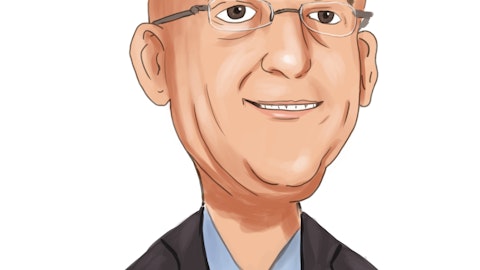So for example, it’s not to say we’re not going to do the 1.5 Tesla study. We’re actually in the process of planning that right now. The difference is that rather than doing it before we finished another project. We’re going to wait until this one project is done and then deploy those same resources to the second one in series as opposed to doing a bunch of different things in parallel. So I would say, there are additional expenses, if you will, required to launch the product, but those expenses are really coming from people rolling off of current projects and on to the new project instead of us hiring additional development engineers and things like that. So hopefully, that helps. That’s kind of why we’re saying, hey, we think we can keep the headcount and the expenses flat.
There is some hiring that would come, just fulfilling additional products, but those new hires would likely be happening inside the gross margin line as they’re either a service provider or an operator on the line that’s designed to make more products, those costs are accounted for elsewhere.
Mathew Blackman: All right. Really appreciate that, Joe. I’m going to try not to be greedy. I’ll get back in the queue. Thank again for taking my questions.
Joe Burnett: Sure. Thanks, Matt.
Operator: Our next question comes from the line of William Wood with B. Riley Securities. Please go ahead.
William Wood: Thanks so much for taking our questions and congratulations on another quarter.
Joe Burnett: Thanks, William.
William Wood: A couple from us. Just actually, the follow-up sort of on the expenses, which you were just discussing about sort of rolling on from one project to the next to the next. I’m just trying to think about with quarter-over-quarter burn and just sort of expenses overall just because, as you know, if you do them once you have one, maybe two bad quarters, and then you increase up but when you do them in parallel, like should we be expecting for this to sort of trick along for multiple, multiple quarters? Or is this more of a limited thing that other revenue and growth or cuts or modifications will sort of balance out going forward? Just a little bit extra, I guess, color on that.
Joe Burnett: Yes. The way I think about it, it’s tough to think about just Q3 or Q4, but if you think a little bit more annually or directionally here, 2024, 2025, these are the years where we expect revenue to sort of significantly outpace expense growth. So that’s where we get scale from these investments that we’ve really already made. So one side of the equation is, yes, maybe we’ll slow down a little bit of development. But the second part of that question is, does that really cost us anything on the top line revenue side in the next two years. And the answer is, as we look a little bit further out is I don’t think it does. I think the competitiveness that we have heard from our early development efforts as we roll into the operating room.
I think the competitiveness we’ve seen of our laser therapy system as we look at some of the other products that are on the market and some early feedback that we’ve gone and simple improvements we continue to make. I think the addition, as I mentioned, of the capability to be able to do GLP studies on the biologics side, which significantly increases the revenue even for the same project, if it’s a GLP one. So these are all things that I think are really additive to the revenue line. And coming from a year in 2023, where that base business really hasn’t grown from a product standpoint. Just reintroducing and reaccelerating that through our software improvements and through this queue of new hospitals that are going to get our navigation system even for our traditional product in the MRI.
Those four things together, I think, put us in a position where if we can keep our operating expenses relatively flat, but then have these 3 to 4 avenues of new additive growth on top, that’s, I think, where we’re going to see the impact. So a long way of saying, I think we are making a couple of modest sacrifices right now, but — we’re doing that with the additional insight that we’re very pleased with the development we’ve made with our products. And maybe we just don’t have to go as fast as we would have two or three years ago because we know these new products are going to be competitive and successful.
William Wood: Right. No, that’s definitely helpful. So when thinking about your partnership, sorry, you had mentioned that you’re really going to sort of, I guess, slow down a number of partnerships that you’ll be looking to expand and sort of shifting towards rather than more towards, I guess, let’s say, better value in your partnerships. Thinking about this going forward, I guess it’s sort of a two-part. How much should we think about the decrease in the new partnerships? Clearly, there’s going to be new partnerships. But then also for your old partnerships, will you be looking to as those sort of looking for it to be re-upped, Will you be looking to include better deals for yourself? And do you think when you reassess those — so the terms of the deal, do you think you’ll lose some of your customers because of sort of the new structuring of what you’re looking for?
Joe Burnett: Yes. I understand the question. I think — I mean, the way I think of it is, there’s always a price to acquire a new customer. And that’s whatever business you’re in, that’s generally less on a percentage basis than keeping an existing customer happy. So our strategy to get into the preclinical services and start working with companies way before they ever even think about treating a human patient with clinical with seller gene therapy. That strategy has always been to prove our value, prove that relationship, make ourselves an essential part of that team so that when these drugs get into their clinical trials and the regulatory process and eventually commercial approval, we’ve been there the entire way. So each one of these natural partnerships that we already have in place, we want to continue to develop those.
So I wouldn’t say we’re firing customers, if you will, which is a term that’s used commonly but as we talk about how to be as productive as we can, how much energy should we go in making sure a company that we know is going to be successful that we’ve been able to see their own capability to see the progress we have made on the bench and pre-clinically, how much of our — if we have a choice of how we’re going to spend our time that day, furthering that relationship into a much more kind of lucrative long-term partnership is better for us in the near-term than signing an early consultative agreement and spending a lot of time and energy for a company that’s just maybe not quite ready yet, right? So I’d say that’s an example. And I think it’s very similar to what we would do on the device side as well.
If we’re going to go and we’re going to launch our navigation system into the operating room, are we going to focus on a small children’s hospital in a rural area that is only doing two or three surgeries a quarter? Or are we going to go after a site that is doing 100 surgeries a quarter. The return on just our current team’s effort and energy is much more beneficial with one hospital that can deliver 10 to 20 times the volume as that other one. So we want to go after the targeted ones during this period of time. So that’s — I’d say we’re going to be doing that on both sides of the business.
William Wood: Right. No, that makes sense. And then just thinking a little bit, I guess, ex US or international, I mean, just curious if there’s any updates whether partnerships or regulatory approval? I know there had been some — if there’s any progress going on in Brazil? And then also, if how sort of this, I guess, shift towards rental and some of these partnership changes – how you think that will be received ex U.S., do you think that will fit in better or if there’s been any feedback there?


